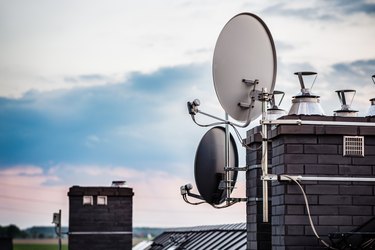
The Direct TV Satellite dish works great when properly pointed. The dish requires a line-of-sight connection and the correct alignment angle to receive the best possible signal. Direct TV offers alignment as a service to optimize the angle, but you can also work the angle yourself. If you're experiencing bad service and need to adjust the angle immediately, you'll find that it's a fairly simple process.
Run a Signal Test
Video of the Day
Your TV is likely not working well and may have a "no signal" message displayed. Attempt a simple power cycle to clear this message. After cycling the power, access the settings and select "view signal strength." Choose "signal meters_"_ and each transponder will test for signal. The results of this make it possible to know where to point the dish. In general, start with a southern-pointing direction before testing. The Dish satellites are aligned to the south and will calibrate more easily when pointed in that direction.
Video of the Day
Access the Dish
After you test the signal, it will give you guidelines for adjusting the angle. First, set aside an adjustable crescent wrench. A small wrench should be ample for most nuts on the dish. You'll also need a ladder and safety equipment to access the dish. In an ideal scenario, the dish is mounted on a deck or area with easy access. Get yourself into position with the new settings written down. It helps to have a partner to test and check the signal while you're fine-tuning the angle of your ladder.
Point the Dish
There are two primary adjustments for the dish. The first is elevation and the second is azimuth. The elevation moves up and down and the azimuth is side to side. Look at the nuts on the dish and you can see which require removal to adjust in each direction. The bolts work on a slider that is easy to adjust in small directions. Adjust the elevation so the setting on the dish matches the recommendation on the TV. Tighten the nut to hold this position. Do the same for the azimuth and tighten everything down. Run another test on the TV to ensure you have a strong signal.
Safety Guidelines
Pointing a satellite dish may require climbing a ladder to reach the dish. Work with a partner and use safety equipment like a harness to avoid falling and potential injury. If you can't reach the dish safely, call a professional to point the dish.